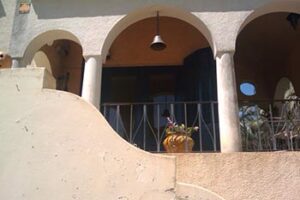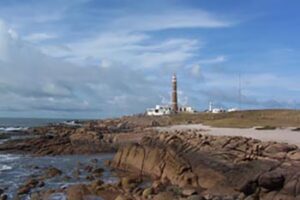Uruguay: Seeing Montevideo, Colonia and other sites in this rarely visited country

By Sandra Scott
It is South America’s best-kept secret. This secret destination has a World Heritage site, a plethora of beaches, thermal spas, working guest ranches, friendly people, and a tranquil ambiance that is hard to find in today’s frantic world. Tucked between Brazil and Argentina, two of South American “tourist biggies,” is Uruguay. It is a nice place to visit and, yes, you just might want to live there. You might even be one of those tourists who is seeking a little herbal pleasure–in Uruguay, marijuana is now legal.
Wooed in the Capital
Montevideo, the capital, doesn’t wow visitors it woos them. As the southernmost South American capital, it is home to half the country’s 3.5 million people whose diversity has influenced the architecture, food, and celebrations. Located on the banks of the Río de la Plata, the city started as a Spanish fortress that became a major port in the mid-18th century luring Spanish, Portuguese, French, Italian, and British immigrants.
Most of the historic aspects of Montevideo can be conquered in a day but the charm is found when wandering along La Rambla. The Ramble stretches along the water from the Old City to the neighborhood of Carrasco past parks and beaches dotted with fishermen, bathers, street performers, and home to the popular weekend Port Market.
Montevideo lets all the stops out during Carnaval. It is not as commercially popular as Rio’s, but it is the country’s biggest party and includes Semana Criolla where participants recreate rural Creole life with equine activities, music, story telling and songs.
Wowed on the coast
Looking to be wowed by a 5-Star world-class hotel on a beach? Then head to Punta del Este, a coastal destination that has attracted visitors for more than100 years. It is where the beautiful people play and second only to Rio as the place to be seen in South America. There are beautiful beaches, whale and seal watching boat trips, great restaurants, Vegas-style shows, casinos, art galleries, golfing, and everything one would expect from a world class destination. Punta del Este is proud of its weeklong Carnaval that rivals Montevideo’s.
A favorite spot to enjoy a spectacular sunset is Punta Ballena only 10 minutes from the heart of Punta del Este. Punta Ballena is also home to the unique Casapueblo. The architecture of the rambling home, studio, and hotel created by artist Paez Villero brings to mind peaks of whipped cream.

Visitors looking for something less Miami-like need only head east or west of Punta del Este to find quiet, laid-back places like Punta del Diablo, a little fishing-surfing village of wooden cabins and winding dirt streets plus miles of sandy beaches to wander. With over 400 miles of coastline there is a beach to wow everyone.
Wandering in Colonia
West of Montevideo is Colonia del Sacramento, an UNESCO World Heritage City, and a great place to wander along the cobblestone streets. Dating from the 17th century, the old city boasts a beautifully preserved colonial ambiance. While it is easy to view the entire historic area in a couple of hours, visitors find themselves sitting for hours at one of the alfresco dining areas.
One of the restaurants, El Drugstore Café, has the interior of a 1920s Model T Ford set up as a private dining area. Antique car lovers will think they are in car heaven. Well-preserved antique cars are a common sight in Colonia as well as the rest of Uruguay.
Occasionally the pulsating rhythm of Candombe can be heard on the streets and in the restaurants. Dancing to the beat of barrel-shaped drums that recall the ceremonial processions from the days of African slavery are the historical personages Mama Vieja, Gramillero, and Escobillero chasing away the bad spirits and encouraging the good ones.
Located on the Rio de la Plata, Colonia offers accommodations in colonial buildings in the historic district and first-class hotels with river views plus the Balinese-style Four Seasons Carmelo is only an hour away. The Four Seasons was the choice of singer Shakira, the actor Robert Duvall, and other notables who wanted to keep the paparazzi at bay.
Getting in hot water

While Montevideo, Punta del Este, and Colonia are the most popular tourist destinations, the thermals north of Colonia near Salto are all-season destinations. In the 1940s while drilling for oil, pockets of pure hot water were discovered that led to the development of resort hotels.
The Hotel Horacio Quiroga, located on the Rio Uruguay, is just one of several resorts with thermal pools, a water park, spa, golfing, sailboat rides, and nightly events that include tango dance lessons. The temperature of the pure water in the pools and piped to the accommodations averages about 104 degree Fahrenheit and is considered therapeutic. Tours of the Salto Grande Dam and several museums are close by.
Working Farms
The interior of the Uruguay is mainly farmland and where visitors can really feel the pulse of Uruguay while staying on an Estancia Turistica, a working ranch. Dotted throughout the country most estancias offer excellent accommodations with the opportunity to get up close and personal with the day-to-day running of a ranch, maybe even riding with the gauchos.
Each estancia is different with many offering bird watching, horseback riding, and other eco-related activities. La Paz Estanc

ia, near Paysandu, was one of the first tourist ranches. It continues as a Charolais breeding farm and sheep ranch.
La Paz has maintained its rustic character with accommodations in an historic 1860s building, their own church, and plenty of open space to breathe free but it also has a pool and a small spa. Guests can help herd the sheep if they so wish, enjoy the spa, or, best of all, do nothing.
Wining and Dining
Still a niche player in the world of wine, Uruguay boasts some 300 wineries with a wine heritage that goes back to Spanish immigrants who introduced grapevines over 250 years ago.
At the Carros de San Juan winery, near Colonia, visitors have the opportunity to taste “tannat,” a local red wine with an extremely tannic nature that often requires years of aging to become drinkable. However, the most common libation is “mate,” a tea prepared by steeping dried leaves of the yerba mate. It is the national drink of Uruguay.
It is a common sight to see Uruguayans carrying what appears to be over-sized leather binocular cases. They hold the water thermos, calabash drinking gourd, and metal sipping straw for their mate. With three-fourths of the land dedicated to grazing beef lovers will enjoy excellent Uruguayan steaks along with their wine and mate.
Way to Go
Pie-shaped Uruguay is the second smallest country in South America after Suriname and about the size of Washington State. It is sometimes referred to as the “New Zealand” or “Switzerland” of South America,” due to its peaceful democracy, strong agricultural economy, and highly literate population.
Direct flights to Uruguay are basically nonexistent but the fun way to get there is by the one-hour Buquebus ferry from Buenos Aires to Montevideo or Colonia. Within Uruguay bus connections are frequent and reasonable, but the roads are good and fairly devoid of traffic making renting a car an excellent option. The climate is mild but remember “beach time” is during the South American summer – December to March.
Uruguay is a place that visitors like to tell their friends about when they return home. “Uruguay is a great place, it has amazing beaches and…,” then stop mid-sentence and think, “Do I really want people to know what a wonderful destination it is? Will telling people ruin it? Should I keep it a secret?” The truth is that a secret this wonderful needs to be shared. For more information check www.uruguaynatural.com.
Sandra and John Scott may be from the small town of Mexico, NY but the world is their playground. They have traveled extensively since the 1980s but now that they are retired they are on the road seven months a year leaning about new places and new cultures plus sharing what they have discovered.
- Valentine’s Day Suggestions…for that Special Person - January 22, 2026
- Missouri Sports Travel Adventure: From Landmarks to Ballparks - January 21, 2026
- What First-Time Visitors Get Wrong About Visiting Iceland - January 15, 2026







